
Many media brands are at a similar place of consternation, trying to answer the existential question:
“What are we?”
Are we a radio station that offers digital options? Are we a multimedia brand that meets the audience where they are? Are we mobile first? Are we a local brand or are we now a national or even worldwide outlet? Are we a linear content creator with on-demand properties? Or are we a live, local, and in the moment media entity?
I know many corporate executives, their boards, and their strategic teams are grappling with many of these nagging issues. Many brands start out in different places but seem to be ending up in a consensus middle ground where everyone’s doing many of the same things.
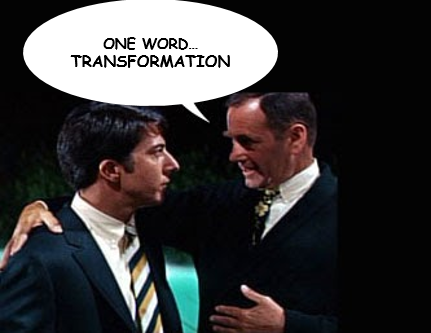 Whether a brand got its start on the FM dial or as an Internet startup, as a podcast or a YouTube channel, most brands end up coalescing somewhere in the middle, creating a whole lot of content, much of it difficult to monetize. When everybody’s doing everything, they all have a tendency to glom together.
Whether a brand got its start on the FM dial or as an Internet startup, as a podcast or a YouTube channel, most brands end up coalescing somewhere in the middle, creating a whole lot of content, much of it difficult to monetize. When everybody’s doing everything, they all have a tendency to glom together.
Thinking about radio, a quarter century or so ago, we seemed to go through an awkward period when the world started moving relatively quickly to digital – and we didn’t. This was a tough time for radio because many marketers started writing the medium off as dated or out of step with the times – something only their parents and grandparents still listened to.
On a good day, radio was nostalgic and something to tune in while driving, but through the eyes of that stereotypical young media buyer or kids, radio broadcasting was in the early stages of irrelevance – an also-ran, yesterday’s news. For radio sellers, it was a tough day at the beach as rates on their inventory of :30 and :60 spots began to fall and they had little in the digital realm to sell.
Fast-forward a decade or two, and radio’s dilemma is much different now, but it’s every bit as dire. While some (but not nearly enough) radio companies and marketers have embraced digital, many have gone from not having enough to sell to having too many offerings – like a rambling, overstuffed Cheesecake Factory menu. Now, there’s actually too much to choose from, and not all of it, frankly, is all that good. Thus, much of it goes unsold or is given away at bargain basement rates.
In the middle of all this, broadcasting’s brand managers and content officers are tasked with trying to figure out where the puck is moving, and if it’s even possible for them to get there. Both are tough calculations but necessary ones as media brands try to achieve innovativeness, resilience, and last but not least, profitability, all while staffs and budgets are shrinking.
Radio broadcasting is littered with many questionable decisions regarding digital over the years – but also many “no calls” where initiatives were booted rather than confronted. Many have struggled with the strategic planning and goal setting process, navigating personnel management and age-old silos, keeping investments realistic, while trying but often failing to set aside the time and necessary financial resources for marketing as well as training staff.
Paul took on some of these same topics in his excellent Tuesday post, “The Revolution Will Not Be Monetized.” I urge you to read it, because it’s thought-provoking and relevant to this conversation. Also, check out the numerous comments that post elicited, many of which described a “digital mine field” that broadcast operators continue to face as they try to cope with new innovations such as AI. Everywhere radio goes in this space is fraught with obstacles, speed bumps, and sand traps. And pretty much everyone can sadly make the claim they’ve invested in a digital “white elephant” that ended badly
this conversation. Also, check out the numerous comments that post elicited, many of which described a “digital mine field” that broadcast operators continue to face as they try to cope with new innovations such as AI. Everywhere radio goes in this space is fraught with obstacles, speed bumps, and sand traps. And pretty much everyone can sadly make the claim they’ve invested in a digital “white elephant” that ended badly
These epic fails are costly, both financially and because they end up taking up precious time and resources. But at least most broadcasters have tried. And given the long term trajectory of linear and digital, they deserve credit for giving these bold initiatives a shot.
The chart below jumped into my inbox over the weekend, similar to the traditional : digital trender we publish every year in our Techsurveys. The trajectories they depict are very similar:
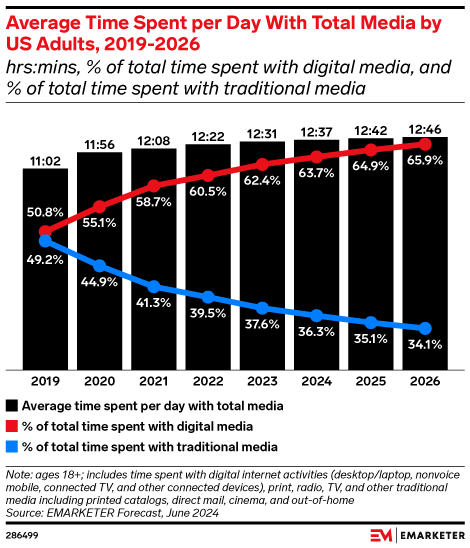
Looks like a trend to me. So, when a radio client expresses concern about the ability to monetize their digital assets, I can sympathize, but only to a point. It may be frustrating to create digital content only to stall out on the ability to generate revenue from it. But given the speed of macro change, broadcasters have little choice but to persevere in the hope they hit the jackpot.
It helps to have a sense of humor at this point in the digital transformation as difficult as that may be. When we see companies like Walmart, John Deere and others scrambling to jump into the techie waters, it’s a whole new ballgame.
And in a world rife with “deep fakes,” AI, and synthetic everything, it’s hard to even know what or whom to believe about who’s doing what and why. Like this headline that made its way across the web earlier this week:

Absurd, of course. What otherwise serious candidate would do such a thing? It’s obviously “fake news.”
Except it’s not. This isn’t The Onion or even The New York Post. It’s the always dependable Reuters and it also happens to be a true story. Apparently.
Speaking of The Onion, who better to summon up a grin or a guffaw than one of the best parodists on the web? The other day, I ran across this absurdly hilarious headline:
The Onion Thinks Print Is the Future of Media
Ha ha!
Obviously, The Onion is lampooning itself. After all, what Internet content company would be so stupid as to actually go back to a print edition as a promotional gimmick to promote digital subscriptions in 2024?
Answer: The Onion
In a true man-bites-dog story, the New York Times’ Benjamin Mullin tells the tale of how one of the best known satirical content factories in America is trying to solidify its digital base by re-creating something very analog – bringing back its print edition. Holy Mad magazine, a forerunner of The Onion that celebrated its heyday way back in the ’60s and ’70s when digital was nonexistent. But today, when newspapers by the bundle are ceasing publication of their print formats – for good reasons – here comes The Onion, embracing an obviously foolhardy endeavor. Or is it?
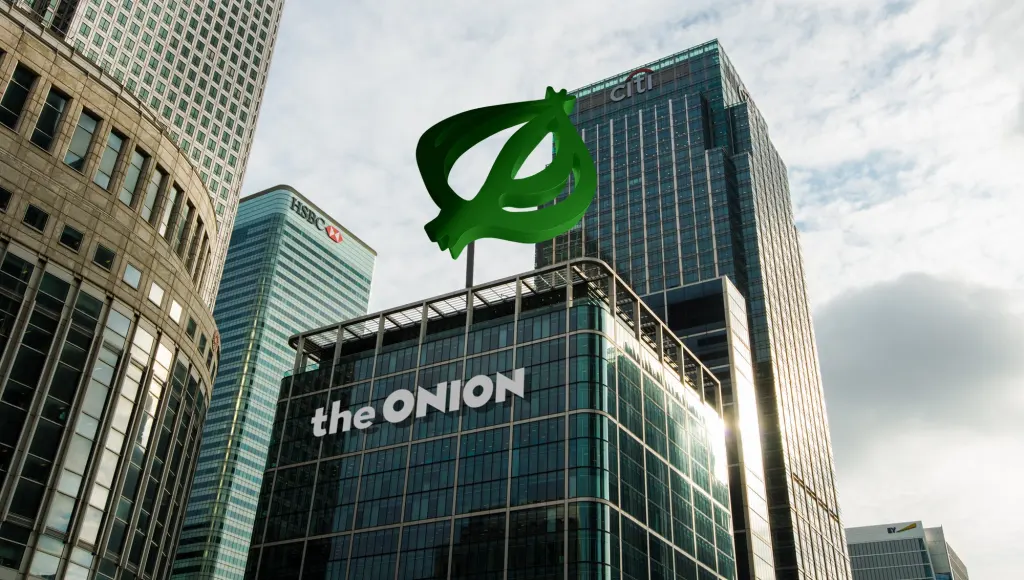
The Onion was founded way back in 1988 in Madison, Wisconsin, later moving south to its current headquarters in Chicago. More recently, the Times reports The Onion has changed owners three times in the last decade.
With that kind of turnover, you might expect a few bumps along the way, even some turbulence. The current overseer of The Onion is tech entrepreneur Bryce P. Tetraeder, CEO of Global Tetrahedron.

Except it turns out this new chief executive is a parody, too. The current owner is actually Jeff Lawson (pictured, I think), co-founder/former CEO of Twilio, described as a cloud communications platform headquartered in the Bay Area. Following so far?
In an Onion editorial published this week – “Here’s Why I Decided To Buy ‘The Onion,” the fictional CEO, “Tetraeder” walks us through the warped logic that inspired him to become the next chump to lay down cash for this sorry rag.
But the best part is the genius nearly-meta rationale for bringing back a physical version of the once-beloved Onion:
“Print. Print is the future.”
The blurry new vision for The Onion – and the entire media ecosphere – follows. And it’s so profound and out-of-the-box that I clipped the cocky, incisive explanation for this can’t-miss plan:
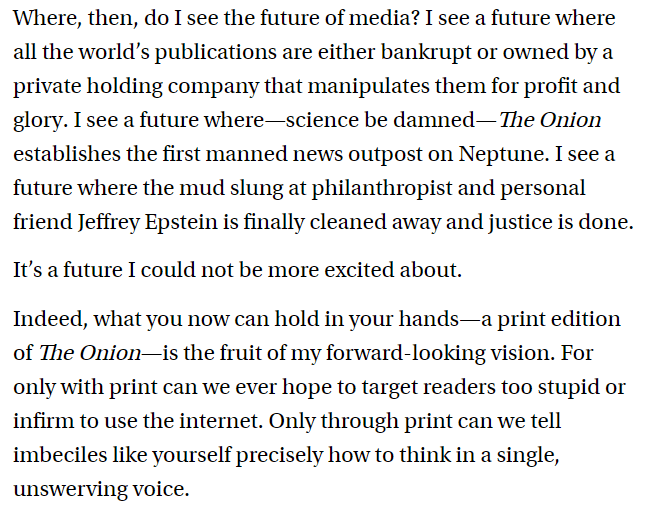
Brilliant.
The only surprising thing is that one of radio broadcasting’s CEOs didn’t think of this first.
As it turns out, The Onion has always had tremendous respect for the radio industry and its professionalism. Case in point: some of its best reporting I’ve ever seen was accomplished for a story that first ran in 2011, proving perhaps that things in radio don’t really change all that much. You get the sense the writer might have even been a radio ex-pat, in between gigs when the story was published. It’s got the look and feel of a piece penned by a “Pro On the Loose.”
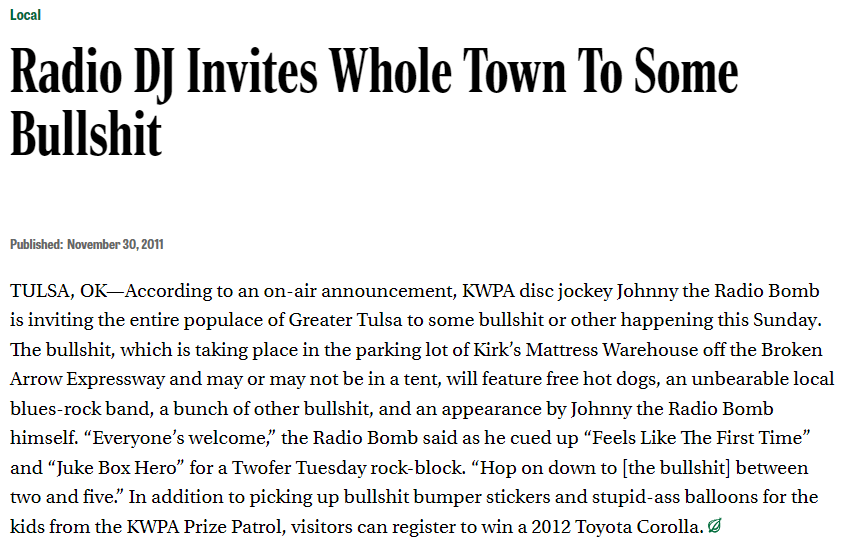
I believe it was WRIF weekend DJ legend Chuck Roast who is credited with coining the phrase, “The best humor is rooted in the truth.” Or maybe it was Jerry Seinfeld, but it’s hard to argue with that logic after reading this poignant radio promotion tale, obviously based on a true story.
Meanwhile, the new/old/retro/throwback print edition of The Onion was being handed out at the Democratic National Convention this week, a cheap promotion for the erstwhile paper and a smart one. Politics is often farce, so why not celebrate the moment with some well-written snark by The Onion?
Its Chicago headquarters are just a 20 minute Uber ride to the United Center, home to the DNC’s kumbaya-fest, only 2.7 miles as the Kamala flies.

But can this sophisticated counter-intuitive analog strategy actually pay off for the enterprising Onion and a dotcom CEO who looks back at the last ten years and believes in his heart of hearts that the third time’s the charm?
Or will there soon be ominous suits being toured through The Onion’s office in the hope of offlloading this brand to the next sucker?
The Times’ Mullin describes the scrappy staff of 15 employees as hopeful about Lawson, its new owner. And for their sake, we can only hope for the best.
Because you know what inevitably follows cuts at The Onion?
Lots of tears.
- “My Favorite Decade Of Music Is The __’s” - June 5, 2025
- Who’s Got It Better? Talent In Commercial Radio vs. Talent in Christian Music Radio - June 4, 2025
- It’s The Christian (Radio) Thing To Do - June 3, 2025




Paul writes: “It helps to have a sense of humor at this point in the digital transformation as difficult as that may be. When we see companies like Walmart, John Deere and others scrambling to jump into the techie waters, it’s a whole new ballgame.”
I think this is an inaccurate representation. Let’s look at Walmart and ask ‘What business are they in?” The answer is retailing. There was a time when that meant putting stuff on shelves and wait for customers to execute a simple transactional function. Today all major retailers, including Walmart, pursue what they call omni-channel. No matter which channel the customer chooses, it is still retailing. The folks ‘doing radio’ must get a better grasp of what business they are in, or want to be in.. I gave a talk at a programmer’s conference in the early 90s cautioning GMs and PDs that they needed to decide if they were in the business of content creation or distribution. Each discipline would require execution against a different set of competitors.
Nearly 30 years later, this seems, for many, to be an unanswered question.
Jack, I think you are hitting the nail squarely on the head: radio doesn’t really understand what business it is in anymore.The comparison to retail is, I think, key.
Consumers (listeners) aren’t stupid – they know when you are presenting a product that is either substandard, or one they don’t want. And substandard product is very hard to sell.
I don’t imagine there are many takers to advertise on the ‘Kenny, the talking horse’s rear end’ show if Kenny is voicetracked, limited to two talk sets an hour, and his content consists of reading the same liners as everyone else in the building.
As you say, the question of ‘what business are you in?’ must be asked (and answered.
Actually, Jack, it was me who wrote this post. (I know some people have trouble distinguishing one of us from the other.)
No argument from me with your premise. We are not in the “radio” business anymore; in fact, you could make the case we haven’t been for a long time. I believe we must account for both content and distribution in order to succeed in today’s environment.
As a native Madisonian, yes, I grew up with the original version of The Onion–and, for that matter, Isthmus (which still exists in print, albeit now monthly). (For those who don’t already know, downtown Madison–including the Capitol–is indeed on an isthmus, which separates lakes Mendota and Monona.) Of note is that the original Onion did feature real coupons and other ads.
On a broader note about print, it’s indeed being used today by some folks to creative higher-end or even collectable publications alongside digital…
https://www.techdirt.com/2024/07/30/making-money-by-understanding-the-difference-between-analog-digital
It ain’t the delivery system, it’s the content. If you want to compete with streaming services and satellite, you have to offer content that’s different and more compelling for the listeners in your metro area. If you’re a music station, that means you need to add value, which generally means programming targeted for your market, and voices talking about things that appeal to local listeners in a timely fashion. When things happen, you need to be able to respond instantly. It’s also important that the quality of your audio is the best each medium can deliver and that commercial sets avoid repetition, poor quality commercials, and dead air.
Quality content, whatt a concept! Thanks,Brian!
Here we are again, wondering where radio fails and digital media succeeds. I think we know the answer to the first part, but the answer to the second is still a mystery. The goal is revenue (obviously) but with inferior content in either platform the revenue can be evasive. I just spent some time with a “new” station that was touted by the industry trades as an exciting new product which -isn’t. Sloppy production (levels and talkovers), meaningless dj interruption, no interaction with the music, minimal content about the region its serving and a (geo-fenced) lengthy stop set with a McDonald’s commercial repeated 4 times. It’s like someone sat down with a list of all the things wrong with radio and said “yeah, let’s do THIS. Is it any wonder why (among other reasons) people are migrating to digital? Those of us in the trenches talk daily-and are energized daily-by these blogs, and yet frustrated that those in charge seem to be looking the other way. Still. Broadcast content-whether it’s online or on AM/FM-can still be enjoyed by the masses. We’re about to see that displayed again when the NFL season begins.
Dave, as alwways, thanks for taking the time to foster a solid conversation on an ongoing topic where broaadcaaster conitnue to struggle.